It could be argued that in recent decades, Wolverine has been the face of Marvel. The only character that gets more exposure is Spider-Man. If you go to the comic store today and look at the shelves you’ll find Wolverine, Savage Wolverine, Wolverine Max, and Wolverine and the X-Men, not to mention that he is a featured member in several other Avengers and X-Men books. This weekend he also gets the honor of appearing for the sixth time in the movie theater.
In honor of the movie’s release, I picked up the miniseries Wolverine: Logan by Brian K. Vaughan. This is a three issue miniseries that provides an introspective look at Wolverine’s past. For most of his comic existence Wolverine hasn’t had memories of his early life and it wasn’t until 2001 and the release of the Origin miniseries by Bill Jemas, Joe Quesada, and Paul Jenkins that Marvel gave him back his memory. Because of that, the 2000s were a decade of discovery for Wolverine with different writers taking their turns to delve into his past.
In Wolverine: Logan Vaughan explores part of Wolverine’s experiences in Japan during World War II. It is a frame story that begins with Wolverine revisiting Japan and returning to a specific place from his memories. The majority of the story occurs in his memories.
Wolverine was born in the late 1800s, but because of his healing factor he is functionally immortal. Our primary story opens with him as a POW in Japan during the war. Wolverine is a hard person to keep caged so it isn’t long before he escapes, bringing a fellow prisoner, an American soldier, with him.
Almost immediately the American soldier, Lt. Ethan Warren, begins to show his prejudices. Initially he shows a realistic level of hatred and racism toward the Japanese for a soldier during the war period. Wolverine, however, does not share his blanket views and when Warren goes over the line and draws a gun on a Japanese woman, Wolverine stops him from shooting. He chases Warren away and the Japanese woman, Atsuko, invites him to her home in Hiroshima.
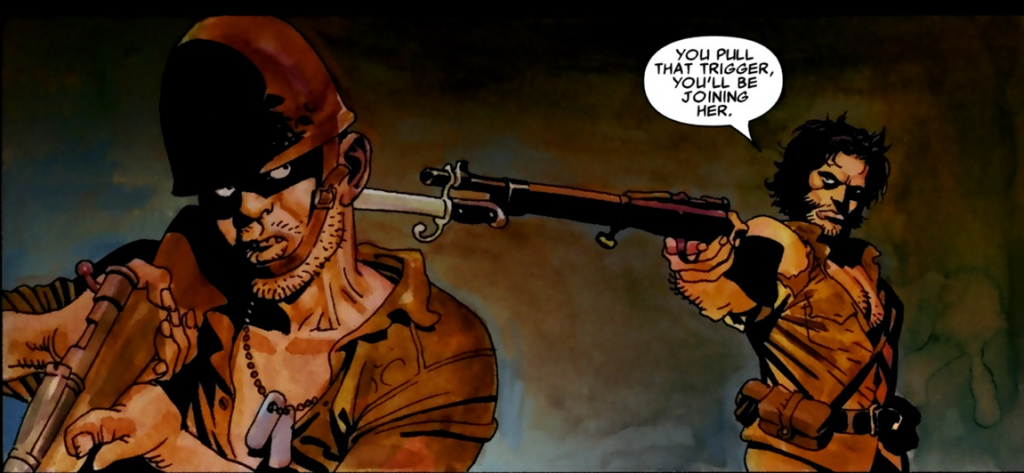
Atsuko opens her home for him and they grow close quickly. It isn’t long before they sleep together, which unsettles Wolverine because he had long thought that he was too disgusting for women to desire. Her acceptance of him makes him fall quickly in love with her, but unfortunately their happiness is very brief because Warren returns. He is bitter and full of hatred and he “kills” Wolverine before making his move on Atsuko.
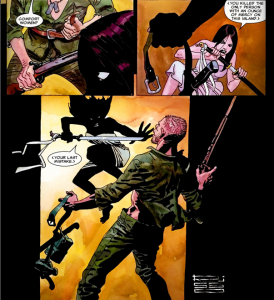
He prepares to rape her, but Atsuko draws a sword and holds her own against him for a while before he finally manages to kill her. Wolverine wakes just in time to see her die and attempts to kill Warren, only to discover that Warren is also a mutant—one who cannot be killed. He doesn’t feel pain or die from injuries, but unlike Wolverine he doesn’t heal. Their fight is interrupted by a plane flying overhead and the dropping of the atomic bomb. Because of his mutation Wolverine survives the nuclear blast, his body slowly knitting back together.
We return to the present and discover that Wolverine had returned to this place from his past in order to confront Warren, who had also survived—only unlike Wolverine, he is much changed. He appears to be perpetually on fire and is little more than a skeleton because he couldn’t die, but also couldn’t heal. Warren overpowers Wolverine quickly and literally rips his heart out of his chest in a rather heavy-handed bit of symbolism. Warren then eats the heart, which somehow heals him back to a more normal state. He thinks he’s won; however, he doesn’t realize that Wolverine can survive even the loss of his heart.
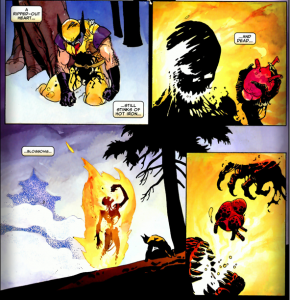
Wolverine, showing absolutely no mercy or hesitation, beheads Warren before passing out. While unconscious he dreams of Atsuko and she offers him a gift. She tells him that she can make him forget that time in Japan—the bomb, her death, all of it—but he would also forget the good parts. We don’t hear Wolverine’s answer as the dream slowly fades away. We are left to interpret for ourselves whether or not we think that means he took the offer.
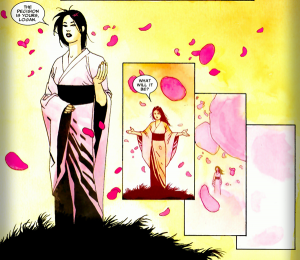
I went into this comic a bit wary because a lot of comic characters have roots in Japan (because of a fondness for martial arts storylines) and a lot of those stories don’t handle the culture well. I was pleasantly surprised here. It didn’t have any glaringly offensive moments and managed to get some historical details right; for example, the families of kamikaze soldiers being sent nail clippings to bury after their death.
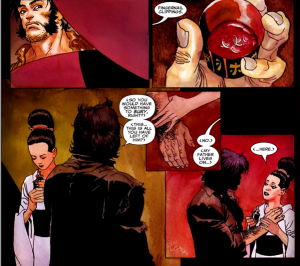
I was also pleased to see that while Warren was full of hatred for the Japanese, the story made a point of not turning the Japanese into the enemy. Because of the World War II setting, Warren’s racism and hatred is realistic. The United States was fighting a war with Japan and a soldier captured and held as a POW would understandably not think fondly of his captors. However, what makes this story interesting is that unlike so many stories set in World War II, the villain turns out to be the American soldier. He was so full of hatred that the war—and likely the circumstances of his mutation—had twisted him and he was willing to kill an innocent woman just because she was Japanese.
While the story managed to provide some small nuance to the war time setting, the plot itself was nothing new. If I had a dollar for every story where a hero falls for a girl, the girl is killed, and the hero seeks vengeance, I would be a rich woman. It’s such a common trope that Gail Simone coined the term “Women in Refrigerators” to describe it. The phrase has since become a verb, and detractors often refer to the killing of a female character in order to give a male character emotional anguish and heroic purpose as “fridging.” Perhaps the worst part is that it isn’t even unique in Wolverine’s history. He’s had similar stories, all with different women dying, over the years.
Atsuko’s fate may not have been original, but she did make me see Wolverine in an unexpected light. Most of my experience with the character has been in team comics and for the most part in those books he is portrayed in a very masculine, confident way, so I was surprised to see his insecurities about his appearance and his sexual skills.
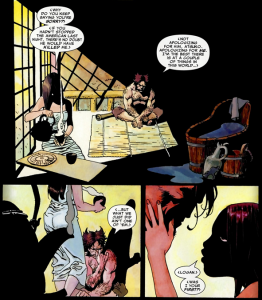
Wolverine actually apologizes so much that Atsuko tells him that she thought she “had bedded a hardened warrior, but you’re just a fragile porcelain doll, aren’t you?” This is an interesting moment because it calls Wolverine’s masculinity into question because he is expressing a lack of confidence. He is a soldier and a killer, but saying “I’m sorry” too often is seen by Atsuko as a weakness.
Wolverine is a character who holds his emotions close and is generally gruff and abrupt when dealing with others. This miniseries pulls back a few of those layers and lets us see more of the man underneath the hard exterior. Ultimately, this story is a version of a coming of age tale. Wolverine remembers the bomb itself as “the girl who made me a man,” and I’ll remember this miniseries as the story that made me see Wolverine as just a little more human.
Wolverine: Logan. Written by Brian K. Vaughan; art by Eduardo Risso. Published 2008; collects Logan #1-3. Find it on Amazon or buy it from comixology.
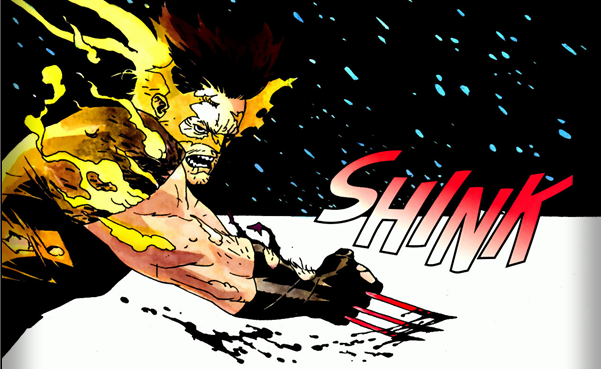
When you mentioned the story was by BKV, it really got my attention. It appears that even though he may have had the usual fridge story that what made his story great were the details. It’s also great to see a story that takes place long enough in the past to allow us to see what made Wolverine the gruff personality that he is.
I wonder how many times he went back and forth to Japan because I’m pretty sure Daken is his kid with a Japanese woman. But in the context of this story, it seems as though she was killed too quickly to have given birth to his kid.
Wolverine spends an awful lot of time in Japan. Daken is indeed half-Japanese by Wolverine’s wife Itsu (so he must have met her quickly after Atsuko). She was killed by Winter Soldier in 1946 while pregnant and Daken was cut out of her womb. Wolverine of course didn’t know about Daken at the time.
Considering those both take place right around WWII, it makes him look like a super rebounder. Although, to be fair, it’s probably more a consequence of retconning than anything else.